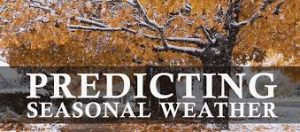
Nationally, we prepare for the probable onset of La Nina. The El Nino Southern Oscillation (ENSO) is showing a propensity for some amount of time where the average temperature in a portion of the equatorial Pacific Ocean will be more than half a degree Celsius below average. This relative chill near the equator affects weather patterns in the Pacific Northwest and Southeastern US in very predictable ways. In particular, those two regions become wetter than normal with a corresponding dry pattern in the Southwestern US. This effect arises as the oceanic waters affect the location and activity of the jet stream. For temperatures, these interactions produce a warmer than average experience for the Southwest and drier areas, with the effects of climate change being valued in putting the entire contiguous US into some level of confidence for above average temperatures.
In Indiana, we see the benefit or harm of above average temperature predictions, but a La Nina event in the autumn does not lend confidence to any particular precipitation regime. “The challenge is Indiana’s location well inland from the ocean coastlines that tend to see bigger impacts from La Nina events”, according to Dr. Beth Hall, Indiana State Climatologist. Indiana could have greater than average rainfall, average rainfall, or below average rainfall. Where La Nina events do creep into Indiana predictions comes later, as winter comes, the jet stream shifts a bit, and the entire state trends a little warmer and wetter. There are two climate regimes in Indiana, however, the snowy north and the temperate south, according the Koppen-Geiger climate classification system. Warmer, wetter temperatures in the north may mean more snow for the Michiana area, while warm and wet for the south means less chance of snow and more rain. However, the likelihood of La Nina conditions persisting through the winter at this time is 55 per cent, according to the Climate Prediction Center. In fact, the chance of La Nina forming during the autumn is currently only 60 per cent, adding another level of uncertainty to the forecasts.
To summarize, Autumn in Indiana is predicted to be warmer than average with some confidence, while no confidence exists in precipitation patterns. If La Nina forms and persists into the winter months, confidence in warmer, wetter than average conditions will increase for our state. Dr. Hall adds that this uncertainty from rather weak ENSO phase outlooks makes seasonal predictions difficult this far in advance. Even the dates of the first hard freeze event (less than or equal to 28 degrees Fahrenheit) show no significant preference during La Nina, Neutral, or El Nino years.
If La Nina does not form and the autumn and winter turn to ENSO-neutral conditions, the cycling of the other climatic oscillations will have more influence over local weather. The Arctic Oscillation, North Atlantic Oscillation, and Pacific-North American Pattern can actually interfere with the ENSO trends we expect when those oscillations are strong enough. None of those oscillations tend to have the staying power of ENSO, however, as they tend to look at the time scale of weeks rather than seasons. For more information on climate outlooks, contact the Indiana State Climate Office at 765-494-8060 or email Hans at hschmitz@purdue.edu.
